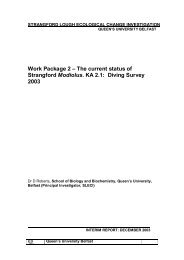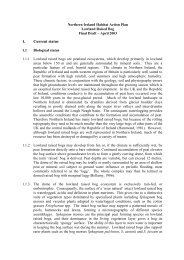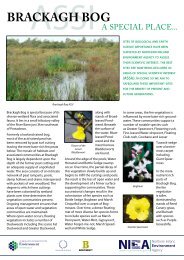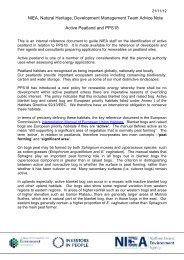Municipal Waste Data Monitoring and Reporting: Interim Guidelines
Municipal Waste Data Monitoring and Reporting: Interim Guidelines
Municipal Waste Data Monitoring and Reporting: Interim Guidelines
Create successful ePaper yourself
Turn your PDF publications into a flip-book with our unique Google optimized e-Paper software.
3.3 APPOINT A DATA REPORTING OFFICER (STEP 1)<br />
The first step that District Councils should take in the development of a <strong>Data</strong><br />
<strong>Monitoring</strong> <strong>and</strong> <strong>Reporting</strong> Structure is to appoint a <strong>Data</strong> <strong>Reporting</strong> Officer.<br />
The <strong>Data</strong> <strong>Reporting</strong> Officer will be the primary point of contact at the District<br />
Council for all issues relating to waste management data, <strong>and</strong> will thus be<br />
required to take ownership of the data generated <strong>and</strong> the KPIs derived from<br />
the data. The Officer will also be responsible for developing a data collection<br />
<strong>and</strong> performance management culture within their Council.<br />
The role of the <strong>Data</strong> <strong>Reporting</strong> Officer is very crucial to the development <strong>and</strong><br />
management of an effective reporting structure. The <strong>Data</strong> <strong>Reporting</strong> Officer<br />
should be a permanent member of staff, at a sufficiently high level to have the<br />
authority required to implement a formal data monitoring <strong>and</strong> reporting<br />
structure, <strong>and</strong> to be responsible for the management of the system that is<br />
developed.<br />
3.4 IDENTIFY WASTE COLLECTION AND WASTE PROCESSING STREAMS (STEP 2)<br />
The next step is the identification of all the Council’s municipal waste<br />
collection <strong>and</strong> processing (treatment / disposal) streams – (i.e. refuse<br />
collections, litter, l<strong>and</strong>scaping, kerbside collections, schools, businesses, civic<br />
amenity sites, l<strong>and</strong>fills, composting facilities, MRFs, etc.) <strong>and</strong> all the data<br />
generated by each stream, particularly those relating to the calculation of<br />
KPIs. This should be clearly documented <strong>and</strong> include data on all the waste<br />
collection <strong>and</strong> processing centres <strong>and</strong> contractors.<br />
A thorough review of the existing or proposed waste management systems<br />
from cradle to grave (i.e. from the point each waste type is produced or<br />
collected to its final disposal point) will enable the Council to assess all the<br />
waste data generated (or could potentially be generated) in the course of their<br />
operations <strong>and</strong> to determine the usefulness of the datasets. This review<br />
should seek to answer questions such as:<br />
• what type of waste is collected?<br />
• how is waste collected, who collects it <strong>and</strong> how often is it collected?<br />
• if there is a contract, how does it operate?<br />
• where does the waste go <strong>and</strong> how is it treated / processed?<br />
• at what stage is the quantity (of waste collected) determined?<br />
District Councils should consider the specific datasets required for<br />
determining each KPI in implementing the process described above. The<br />
Council should however not limit itself to just the data needed for calculating<br />
KPIs. Any other data that would be useful for monitoring <strong>and</strong> managing its<br />
overall municipal waste management performance should also be identified.<br />
MUNICIPAL WASTE DATA MONITORING AND REPORTING: INTERIM GUIDELINES 7

















